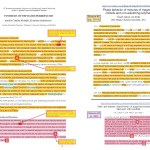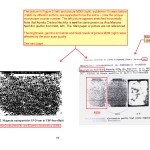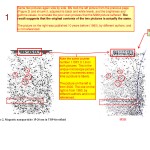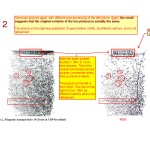The offending paper is a conference proceedings paper authored by Aurelia Cristina Nechifor and Ecaterina Andronescu, the current minister of research of Romania, published in 2003 at the 13th Romanian International Conference on Chemistry and Chemical Engineering.
As can be seen below, 7 international experts in the field confirm that the work constitutes plagiarism and falsification of data.
[30 Nov 2012] Emeritus Professor Ian J. Bruce offered the 7th review.
- Outline
- Independent Reviews
- Prof Christian Holm (Germany)
- Dr Xiaosong Wang (Canada)
- Dr Philip J. Camp (UK)
- Prof David Tomanek (US)
- Dr Tapas Sen (UK)
- Prof Mehmet Sarikaya (US)
- Emeritus Prof Ian J. Bruce (UK)
- Report
- Documents
Outline
The 2003 conference paper by Nechifor and Andronescu was found by experts to plagiarize 3 previous works: - a PhD thesis from 2001, pages 18-19,
- a journal paper from 2001, page 1 ,
- a Source-#3-1993-Page-3 from 1993, page 3. The latter was published by members of the same Nechifor family.
The most striking is the reuse of a microscope (micrograph) image from 1993 and the attempt of the authors to mask the falsification by widening the image horizontally. However, the microscope unique image counter number is the same on both images. We went further and post-processed the 2003 image, and the result suggests that the original contents of the two images is also the same.
This conference paper appears on the list of publications (local copy) at no 167, of Prof Ecaterina Andronescu, although an electronic copy could not be found. The copy of the paper that was analyzed and reviewed here was submitted to us by someone from Romania.
The work has been part of the PhD of Aurelia Cristina Nechifor, which she defended in 2005. Dr A.C. Nechifor was already a lecturer in 2006.
Prof Ecaterina Andronescu, was at the time minister of research and dean of the Faculty of Industrial Chemistry at the Polytechnic University in Bucharest. On 2 July 2011, she was reappointed minister of research by the prime minister, Dr Victor Ponta. The prime minister’s PhD thesis was analyzed and reviews by Intgeru.org, as well as by other independent institutions (e.g. the home university, The University of Bucharest) and was found plagiarizing around 115 pages out of roughly 290 effective text pages in a copy-paste style.
Yesterday, 28 Nov 2012, minister Andronescu, declined the retraction of the PhD title of Dr Victor Ponta.
Follow-up Paper
In the same year, 2003, the same authors publish a follow-up journal paper in the local Romanian journal “Revista de Chimie”, which contains the same offending microscope image, this time slightly shrunk horizontally.
This paper is also cited (as [4], see red highlights) several times in the offending orange and pink paragraphs of the above offending conference paper, whereas the original text from the foreign authors either contain truthful references to original papers, or no references at all. This adds to the plagiarism offense as the reader is further mislead into interpreting that Nechifor and Andronecu are the original authors of those paragraphs, an action found unacceptable by our reviewers.
Independent Reviews
We want to extend our warmest thanks to the following international academics for taking the time to do these reviews and for publicly upholding academic values.
Experimental section and paragraph in the “Results and discussion” section: I think it definitely indicates the non-scientific act of stealing intellectual property from materials that the authors have definitely read, but were not willing to quote properly. Sentences and whole paragraphs were obviously taken from sources #1 (Phase behavior of mixtures of magnetic colloids and non-adsorbing polymer, by Gerard Antonie van Ewijk) and #2 (T.A. Osman, G.S. Nada, Z.S. Safar, Tribology International, 2001, 34, 369). The sentences are too similar to have been written by the authors without having the sources right in front of them. For the exact preparation of magnetite, it seems that they have used different chemical compounds, but that they copied almost exactly the wording of the procedure published by Gerard van Ewijk. Another unacceptable feature can be found in the first sentence of the preparation section: a citation in source #1 to Bee et al. (1990) has been replaced with an incorrect citation to themselves.
The second part of the case I consider even more serious, since here a definite deception takes place. To steal a picture from someone else, and claim it shows something of your own work reminds me of the work of the German “Wunderkind” Jan Hendrik Schön, who managed to publish several highly ranked papers in Nature and Science with faked data, using the same graph several times with different interpretations. This is definitely unacceptable, criminal behavior, a fraud, and in my opinion it has to be legally prosecuted. For this kind of behavior no excuse should be allowed.
Q2. Grey zone. Are there elements that are controversial but which cannot be clearly qualified as misconduct?
A grey zone may be the use of several introductory sentences like, Ferrofluids are an interesting group of liquids,… and so on, since this is common knowledge and it contains no detailed insight into the matter. Sentences like this appear everywhere in talks and papers, and although someone probably has first written it in this way, it is sometimes hard to give a reference to the actual author (if he/she can be identified at all). However, it is again a cruel attempt to try and deceive the readers, by taking almost a whole paragraph word-for-word out of source #2, and adding to this text a reference to themselves, which by all standard citation standards would mean that they consider this as an outcome of their own innovative thinking. Any educated scientist would feel obliged (and certainly should feel obliged) to give here the original authors (of source #2) the proper acknowledgement.
Q3. Significance. What would be the outcome and impact if colleagues from your institution or country published a similar work? You may think of conceivable procedures, sanctions, impact on individuals, research, institution, public perception etc.
I think that this would call for an investigation by the legal bodies of the scientific institute where the involved persons are employed. Any scientific institute which wants to keep its reputation will have to investigate this matter and draw the appropriate conclusion if the evidence for scientific misconduct is proven so obviously, as it is in this case. Since it is an article by two authors there is also the need to assess the respective misconducts of each author separately. Such persons should, depending on the severeness of the misconduct, be issued a caution, be banned from continuing to publish, or blocked from getting money from any funding agency. Furthermore I think that all legal means should be used to try to expel the persons from continuing to pursue science in academia.
I believe that in the German system we currently have a functioning system which has demonstrated that it is able to take measures against fraud, like in the case of scientist J.H. Schön, or in the cases of plagiarism and irregularities that appeared in the Ph.D. theses of several highly ranked politicians who subsequently have lost their doctoral degrees, i.e. the cases of former German defense minister K.-T. zu Guttenberg, and E.U. politician S. Koch-Merin, to name just two recent examples. Nevertheless, these cases have raised serious doubts and concerns about the integrity of politicians, and we as scientists are well advised to take immediate and strong measures against obvious cases amongst ourselves, since otherwise scientists could have in the future the same reputation as politicians, a presently still unthinkable scenario to me.
The authors did not have any concerns of ethical norms, when they were writing or copying the paper.
Q2. Grey zone. Are there elements that are controversial but which cannot be clearly qualified as misconduct?
There is no grey zone in this case.
Q3. Significance. What would be the outcome and impact if colleagues from your institution or country published a similar work? You may think of conceivable procedures, sanctions, impact on individuals, research, institution, public perception etc.
With respect to plagiarism of a research article, journal editors may decide on penalties such as the authors being barred from submitting new papers to their journal and/or organization. Funding organizations, such as NSERC in Canada, would review the facts and the action taken could be complete freezing of research funds, prevention of future applications, etc.
The example provided is so obvious and serious that I believe the highest level of sanctions is reasonable.
The authors should not be allowed to work in academia, but I do not know what jobs they can be trusted with.
The current material contains evidence of two forms of scientific misconduct: plagiarism and falsification of data. Both forms of misconduct contravene ethical guidelines for scientific research. For example, both the UK Research Integrity Office (link) and the Royal Society of Chemistry (link) clearly define what constitutes scientific misconduct. My institution has formally adopted the guidelines provided by the UK Research Integrity Office.
The description of a chemical synthesis is almost identical in form to one found in a PhD thesis published online by Utrecht University in 2001. Although the precise chemical details are different, and in some cases omitted altogether, the extent of the similarity is far greater than could have occurred just by chance, even allowing for the fact that there are only so many ways of describing some common chemical procedures. There is no reference to the PhD thesis, only to work previously published by the authors. In the PhD thesis, the chemical synthesis is attributed to earlier work published in 1990. The current material therefore appears to have been plagiarised from the PhD thesis.
Another example of plagiarism appears in the opening sentences of a section reporting results: four sentences are identical to those written in an original research article published in 2001. Three articles are cited in each case: two citations are the same as in the 2001 article; and one citation is made to the authors’ own work.
In each case, the plagiarism represents an unambiguous and unacceptable contravention of guidelines for ethical conduct in science.
Probably the most serious instance of misconduct is in the falsification of data. A microscope image is presented as having been obtained by the authors, when it fact it was published some 10 years earlier by different authors: the original work was not cited. I note that one of the current authors (A. C. Nechifor) has the same affiliation as one of the authors from the earlier work (G. Nechifor), and that A. C. Nechifor and G. Nechifor have published works together: I found 15 articles on ISI Web of Knowledge as of 20/11/12. (Note that there has been no mix-up between A. C. Nechifor and A. M. Nechifor, the latter being a co-author on the earlier work.) These connections might have provided the current authors with the means of accessing the data.
This apparent act of falsification of data is in direct conflict with all acceptable norms in scientific research, and it directly contravenes guidelines provided by learned societies and organisations.
Q2. Grey zone. Are there elements that are controversial but which cannot be clearly qualified as misconduct?
The only possible grey area is in the description of a chemical synthesis, referred to above. It can sometimes be difficult to rephrase the description of simple laboratory procedures. In this material, however, almost entire paragraphs have been adapted by simply changing the chemical reagents and experimental conditions. Given the extent of the similarity between the original published work and the current material, it is highly unlikely that this would have occurred just by chance.
Q3. Significance. What would be the outcome and impact if colleagues from your institution or country published a similar work? You may think of conceivable procedures, sanctions, impact on individuals, research, institution, public perception etc.
I would be appalled if any of my colleagues engaged in any form of scientific misconduct, such as that outlined in this case. I can only speculate as to what action would be taken if instances of scientific misconduct were suspected in my own institution.
At the very least, investigations would be carried out at departmental and institutional levels in order to ascertain the culpability of individuals and to determine how data were accessible for the purposes of falsification. In the present case, it is possible (and I stress that this is speculation) that there has been a degree of collusion between authors, which is particularly serious as it suggests a problem at an institutional level.
If it is concluded that staff have contravened guidelines formally adopted by the institution, then this will have constituted a breach of contract. Therefore, disciplinary action and/or legal proceedings could follow.
The journal concerned would naturally be informed of the findings of an investigation. Instances of scientific misconduct, such as those detailed here, violate the ethical guidelines of most respectable journals and therefore I would anticipate editorial retraction.
I do not know how funding bodies would react, but at the very least, allegations of scientific misconduct would influence peer-review of the authors’ grant applications.
Beyond the results of formal procedures, the impacts on individual staff and the institution would be devastating. Public perception would be dictated by press coverage, and (quite rightly) this would be overwhelmingly negative. In turn, this would taint everyone in the institution.
Quite frankly, the consequences of scientific misconduct do not bear thinking about.
The conference proceedings report by Aurelia Cristina Nechifor and Ecaterina Andronescu contains plagiarized components. The clearest offense against common ethical norms is the reuse of a formerly published micrograph taken by other authors and not referenced in the study. I would consider extensive reuse of published formulations in the “Techniques” and “Summary” sections a minor offense in comparison to not quoting the source.
With the rapidly spreading plague of scientific misconduct, the scientific community must establish efficient protection mechanisms. A possible way to enforce scientific integrity is to black-list offenders in a publicly accessible resource for a limited time, with linked documentation and non-anonymous expert reports. Since black-listing will affect the peer-review process for publications and grant support, this single measure should discourage dishonesty. Black-listing should be based on Researcher ID to avoid cases of mistaken identity.
Q2. Grey zone. Are there elements that are controversial but which cannot be clearly qualified as misconduct?
Assuming that the synthesis procedure, reported first by Gerard Antonie van Ewijk, is still considered non-standard and unique in the field, then not referencing the original work of Gerard Antonie van Ewijk is a serious offense. If, on the other hand, the technique should have become very common in the scientific community, there should be no reason for Aurelia Cristina Nechifor and Ecaterina Andronescu to call their research “original”.
Q3. Significance. What would be the outcome and impact if colleagues from your institution or country published a similar work? You may think of conceivable procedures, sanctions, impact on individuals, research, institution, public perception etc.
Plagiarism and scientific misconduct are considered very serious offenses at my institution and any well-established scientific institution in the developed countries. Sanctions range from turning down a PhD Thesis with plagiarized components to terminating academic appointments and, in well-publicized cases (e.g. Hendrik Schoen), withdrawal of a granted PhD title. Those found guilty of serious offenses have a hard time finding a job in research.
Reading the original manuscript published by Aurelia Cristina Nechifor and Ecaterina Andronescu in 13th Romanian International Conference on Chemistry and Chemical Engineering 2003 (Section 4 – Quality Control and Analytical Chemistry) and comparing with the various past publications by other authors, I would say that it is a clear academic misconduct and shouldn’t be allowed to happen in the scientific community which is purely run by trust and honesty.
Authors have used other’s work (Transmission Electron Microscope image and text) and failed to provide the sources indicating that it is a deliberate attempt to claim that those are their own work. It is fully unethical and shouldn’t be allowed to happen.
Q2. Grey zone. Are there elements that are controversial but which cannot be clearly qualified as misconduct?
Aurelia Cristina Nechifor and Ecaterina Andronescu have described the experimental part where they have copied the text from a PhD thesis written by van Ewijk and changed the name of the chemicals, temperature, time etc. as appropriate for their experiments. Once again Aurelia Cristina Nechifor and Ecaterina Andronescu have written the 1st paragraph in results and discussion part which is in verbatim with Osman et al (Tribology International 2001, 34, 369-380) without citing the source. In fact authors have referred their own unpublished work (reference 4) without citing Osman et al (Tribology International 2001, 34, 369-380) in this context.
Q3. Significance. What would be the outcome and impact if colleagues from your institution or country published a similar work? You may think of conceivable procedures, sanctions, impact on individuals, research, institution, public perception etc.
The consequence for such act could be disastrous as it undermines the institutional ethics and reputation. It can also undermine the public perception of research which is mostly funded by tax payers’ money. It can also mislead the scientific community about the authenticity of the work hence wasting valuable time and efforts of other scientists. It is a clear case of disciplinary action against the responsible persons and could eventually lead them to leave their current profession. Finally a published work with such an order of misconduct will have an immediate effect such as retraction from the published proceedings, and so should be any PhD degree awarded with reference to it, in order to minimise the damage caused by the authors to the scientific community, their own institution and country.
They do not comply with ethical norms at all. The image should have been used with an official permission of the authors themselves (if the work was not published) or the journal, if the work was published (which is the situation in this case). In addition, the previous work should also be indicated as “Courtesy of…” in the relevant figure caption. The earlier paper from 1993 should have been cited and included in the references, and any further modification to the previous protocols should have been explained in the text as “The procedure has been adapted from ref X” or “(…) modified from that discussed in ref X”.
Q2. Grey zone. Are there elements that are controversial but which cannot be clearly qualified as misconduct?
There is a no grey zone in this case. The images were taken from someone else’s publication and used without permission. Even acknowledgement or citation would not be sufficient in this blatant case.
Q3. Significance. What would be the outcome and impact if colleagues from your institution or country published a similar work? You may think of conceivable procedures, sanctions, impact on individuals, research, institution, public perception etc.
The image is real problem here in the source paper. If the incident was made public, the perception of the scientific community about the authors would be very damaging to them; also, the university would have taken serious action about the plagiarizing authors. The journals would banish these authors from publishing in their journals.
The article published by Aurelia Cristina Nechifor and Ecaterina Andronescu “Synthesis of TBP-based Ferrofluids” is heavily plagiarised from the PhD thesis of Gerard Antonie van Ewijke (1971) and Osman et al (2001) Tribology International 34, 369-380. The direct reproduction, within this case, with little or no modification, of original text previously published by others in my opinion represents gross professional misconduct on the part of Nechifor and Andronescu. Their behaviour does not comply in any way with the ethical norms expected from researchers who should be engaged in, and reporting about, original, new research.
Q2. Grey zone. Are there elements that are controversial but which cannot be clearly qualified as misconduct?
There appears to be no ambiguity with respect to the professional misconduct of Nechifor and Andronescu in this instance. Consequently there are no controversial elements with respect to the Authors plagiarism and misconduct.
Q3. Significance. What would be the outcome and impact if colleagues from your institution or country published a similar work? You may think of conceivable procedures, sanctions, impact on individuals, research, institution, public perception etc.
If such an instance of professional misconduct were to be identified in my university then a formal investigation would be carried out (most likely under the University’s disciplinary code) and if plagiarism were to be proven the article would be retracted and the individuals concerned disciplined.
Report
| MISCONDUCT: | Plagiarism in conference proceedings article |
|---|---|
| TITLE: | SYNTHESIS OF TBP-BASED FERROFLUIDS |
| Conference: | 13th Romanian International Conference on Chemistry and Chemical Engineering, Section 4 – Quality Control and Analytical Chemistry |
| Date: | 2003 |
| Authors: | Cristina Aurelia Nechifor, Ecaterina Andronescu |
| INSTITUTION (TIME OF WRITING): |
Faculty of Industrial Chemistry, Politehnica University of Bucharest |
| POSITION (TIME OF WRITING): |
- Aurelia C. Nechifor : PhD candidate. - Ecaterina Andronescu : Minister of Research and Full professor. |
| PHD SUPERVISOR (TIME OF WRITING): |
Prof Ecaterina Andronescu |
| CURRENT POSITION: | - Aurelia C. Nechifor : Lecturer (contact us if you have more accurate information) - Ecaterina Andronescu : Minister of Research and Full professor. |
Documents
| Head-To-Head Comparison: | Head to Head Comparison |
|---|---|
| Offending paper | Conference Paper (2003), pages 67, 69 |
| Follow-up Paper | Follow-up Paper (2003) - Reference [4] in the above offending paper, contains same microscope image from 1993. |
| IDENTIFIED SOURCES: |
|
| Samples: |     |

